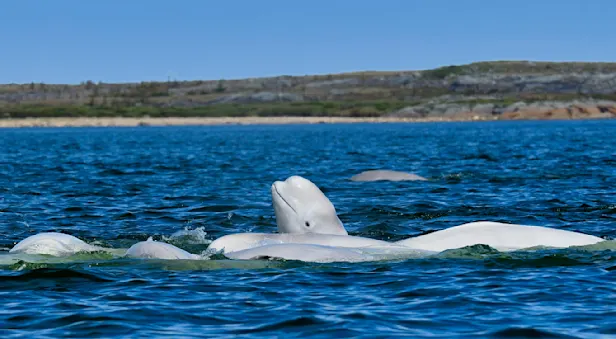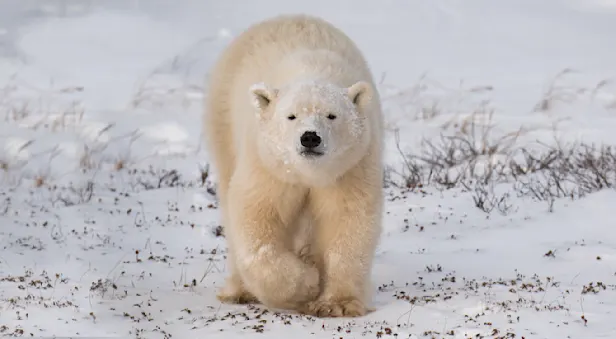Know Before You Go
Arctic Fox Facts | Churchill Summer Wildlife Guide
The Arctic is a harsh environment in which few species can survive. The Arctic fox, a specialist at adapting to circumpolar regions, is an exception. Only as big as a large domesticated cat, this canine is one of the tiniest mammals to actively spend the long Arctic winter above the surface of the snow.
Physical Characteristics
In winter, the Arctic fox looks bulky and rounded due to its long, thick, soft fur coat. Underneath their fur is a rather skinny body, and they typically weigh just 10 pounds. Despite living in temperatures that reach –20°F and lower, Arctic foxes are able to maintain their core temperature due to adaptations that include a short muzzle, legs and ears, and densely furred footpads. Using its keen hearing and profound sense of smell, the Arctic fox can detect lemmings, an important food source, scurrying under the snow’s surface. Living on the coast and offshore ice, the Arctic fox is a more skilled swimmer than other canines. Its shrill bark is easily identifiable, but the Arctic fox also periodically purrs in a cat-like manner.
Arctic foxes are dimorphic, which means they can exhibit one of two phases—brown or white. They are the lone canine to undergo a change in coat color from summer to winter. The white Arctic fox begins molting in early July to expose its summer fur, which is fawn-colored and brown. After approximately eight weeks, they begin to regrow their white coat for winter. Blue phase foxes have a pale gray coat in winter and a dark bluish one in summer. Though the reasons aren’t totally clear, the coastal populations of Jan Mayen Island, West Greenland, the Commander Islands and the Pribilof Islands are usually blue, while 99 percent of the continental foxes living on the mainland of Canada are white.
Behavior
During winter months, Arctic foxes do not hibernate. They exhibit a combination of nomadic and communal behavior, typically establishing small groups to search for food. These foxes usually construct dens in a rock mound at a cliff base or in stumpy knolls, 3 to 13 feet high, on the tundra. Some of these complex dens—with between four and eight entrances and a tunnel system that can reach over 300 square feet—have provided shelter for multiple generations of foxes, since they are used over and over for centuries. Each den, usually built in cliffs a minimum of a mile apart, houses a family—a social group comprised of the litter, a male adult, and two vixens. Born the previous year, one of these females is non-breeding but remains to assist in caring for the new litter.
Reproduction
Arctic foxes become sexually mature as early as 10 months old. They are monogamous, generally mating for life. Breeding usually occurs between February and March, and afterward, the mates are hard-pressed to find a birthing den, since permafrost must be low enough beneath the snow to allow the foxes to burrow. Gestation lasts approximately 53 days, and litters are born in the spring and early summer. The number of kits in a litter depends upon the abundance of food, especially lemmings. Mothers typically give birth to between five and eight pups, but litters have been known to reach the incredible size of 25 kits.
Kits are born deaf, blind and without teeth. Each pup is the mere size of a tennis ball and they eagerly suckle from their mother. After they are weaned, kits emerge from their den at 2 to 4 weeks old. Fathers stay with the pups, helping catch prey to feed the young. He copulates again with the female just a few weeks after birth.
Feeding Habits
Arctic foxes leave their birthing dens by the end of August, separating to hunt from dawn until dusk. In summer, the Arctic sun can shine for up to 24 hours a day, and foxes will continue to search for prey as long as there is light. They are opportunistic hunters, eating practically any animal, including small mammals and carrion. They will also eat insects, berries and even excrement.
In the summer, the central component of an inland Arctic fox’s diet is lemmings. During this season of bounty, foxes will make caches of food in preparation for the long, lean winter ahead. They store the food under stones in their den. Alwin Pedersen, a Danish naturalist, found one store that had enough birds to keep a fox fed for a month. It contained a long, neatly arranged row of two murres, four snow buntings and 36 dovekies, plus a pile of dovekie eggs.
During winter, Arctic foxes become nomadic, often following polar bears to the coastal sea ice and scavenging the carcasses of bearded and ringed seals. The population of Arctic foxes rises and falls every three to five years, in a cycle dependent upon the number of lemmings. When prey is scarce, Arctic foxes have been known to migrate hundreds or thousands of miles.
The Struggle for Survival
There is a high rate of mortality among Arctic fox populations. Parents often abandon their litter of pups, and aggressive kits will sometimes kill their siblings. The deadly disease rabies ravages up to 20 percent of the Arctic fox population, increasing in times when immune systems are weakened from starvation, another killer. Although these creatures can live up to 10 years the wild, only one out of 25 will survive past 4 years old.
Header Credit: Richard Field
See Arctic Foxes on These Churchill Trips

Belugas, Bears & Summer Wildlife of Churchill
Meet hundreds of friendly beluga whales up close via Zodiac and kayak, and look for caribou, polar bears, Arctic fox and more on this exhilarating summer adventure in the Canadian subarctic.

























